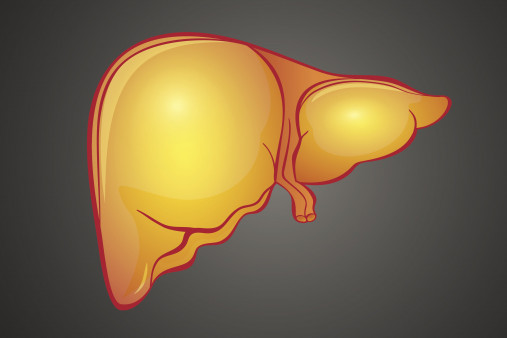Non-alcoholic fatty liver disease (NAFLD) is a growing cause of serious liver problems and liver-related death among people living with HIV now that hepatitis C can be cured, according to research presented at the 2019 International Liver Congress last week in Vienna.
As highly effective treatments for hepatitis B and C lead to reduced mortality among people with HIV, “NAFLD is becoming an increasingly important cause of liver disease,” said presenter Zobair Younossi, MD, PhD, of Inova Fairfax Medical Campus in Falls Church, Virginia. In the future, he suggested, NAFLD could become the leading cause of liver disease in this population.
As people with HIV are living longer thanks to effective antiretroviral treatment—almost half of HIV-positive people are now over 50—non–HIV-related conditions, such as cardiovascular disease, non-AIDS cancers and liver disease, account for a rising proportion of illness and death in this population. As HIV-positive people become healthier, they are also more likely to be overweight, Younossi noted.
Many people living with HIV also have hepatitis B virus (HBV) or hepatitis C virus (HCV), which are transmitted in some of the same ways. But an effective HBV vaccine has been available since the late 1980s, antiviral medications like Viread (tenofovir disoproxil fumarate) and Baraclude (entecavir) can keep hepatitis B under control and hepatitis C can now be cured with direct-acting antivirals. Among HIV-positive people—like the U.S. population as a whole—viral hepatitis is falling as a cause of serious liver disease while NAFLD is rising.
Non-alcoholic fatty liver disease and its more severe form, non-alcoholic steatohepatitis (NASH), are caused by the buildup of fat in the liver. This triggers inflammation, which over time can lead to the development of fibrosis (scarring), cirrhosis (severe scarring and loss of liver function) and liver cancer. There are currently no effective treatments for NAFLD and NASH, and management of the disease relies on lifestyle changes, such as weight loss and exercise.
Younossi’s team looked at the prevalence and mortality trends of NAFLD, viral hepatitis and other liver diseases among people with HIV receiving Medicare, which generally is available to those 65 or older and some younger people with disabilities.
Searching the medical records of more than 47,000 HIV-positive people, they identified 10,474, or 22.3 percent, with liver disease. Hepatitis C was the most common cause, accounting for 5,628 cases (53.7 percent). This was followed by NAFLD, at 2,629 cases (25.1 percent). Other causes were less common, including 1,374 with hepatitis B (13.1 percent), 645 with HBV and HCV coinfection (6.2 percent) and 198 with other liver diseases (1.9 percent).
Between 2006 and 2016, the prevalence of viral hepatitis among people with HIV decreased from 27.8 to 24.1 per 100,000 in the population (an annual percentage change of -0.9 percent), while the NAFLD rate more than doubled from 5.3 to 11.6 per 100,000 (an annual percentage change of +7.2 percent), Younossi reported.
A similar pattern was seen for mortality, although fatty liver disease still accounted for fewer deaths than hepatitis C. Of the 2,882 total deaths during the study period, just over a third (36.2 percent) were related to liver disease. Of these, half were attributable to HCV, 20.3 percent to NAFLD, 14.4 percent to HBV, 11.9 percent to HBV/HCV coinfection and 3.9 percent to other liver diseases.
During the same decade, mortality rates related to viral hepatitis fell from 3.8 to 2.6 per 100,000 (an annual percentage change of -5.2 percent), while NAFLD mortality rose from 0.2 to 0.8 per 100,000 (an annual percentage change of +8.9 percent).
In a multivariate analysis that took multiple risk factors into account, HIV-positive people with liver disease had longer hospital stays, higher inpatient and outpatient costs and a higher risk of dying within a year compared to those without liver disease.
Given the increasing impact of fatty liver disease among people with HIV, “clinicians must be vigilant in identifying and managing NAFLD in these individuals,” Younossi urged.
A related study looked at NAFLD in two cohorts of people living with HIV in Canada and Italy who did not drink much alcohol and did not have hepatitis B or C. Among 1,228 people whose records were reviewed, 31.8 percent had NAFLD. Of these, 25.2 percent were considered at risk for liver disease progression based on elevated liver enzyme levels or the presence of significant fibrosis.
“These studies indicate the changing profile of liver disease in patients with HIV. Whilst viral hepatitis is still the major cause of liver disease in such groups, NAFLD is becoming a much commoner problem,” European Association for the Study of the Liver vice secretary Philip Newsome, PhD, said in a conference press release. “This reinforces the need to study therapeutic agents in patients with NAFLD and HIV, an area which is seldom examined.”
Click here to view the International Liver Congress abstracts.
Click here to learn more about NAFLD and NASH.







Comments
Comments